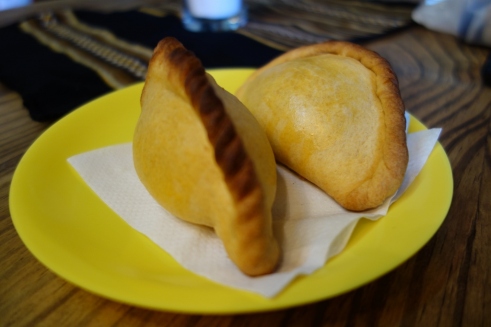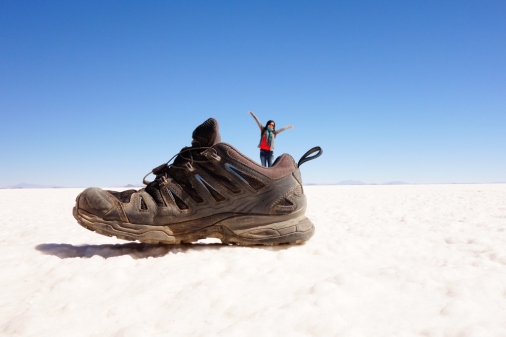Back in the beginning of July, Jason and I made the decision to purchase a multi-city airline ticket that would bring us through the countries we wanted to visit in South America.
When we first left Canada for our travels, we had nothing planned. Two weeks in, we had a rough idea of the route we wanted to take through South America: Colombia, Peru, Bolivia, Chile, and Argentina. So we purchased a multi-city airline ticket that would take us through the major cities in those countries. Although it locked us into set travel dates, the money we saved purchasing a multi-city ticket (vs. purchasing the tickets between each of the cities separate) seemed like it was well worth it.
- Leg 1: Bogota (Colombia) to Lima (Peru)
- Leg 2: Lima (Peru) to Santa Cruz (Bolivia)
- Leg 3: Santa Cruz (Bolivia) to Santiago (Chile)
- Leg 4: Santiago (Chile) to Buenos Aires (Argentina)
At first things were going well – we caught our Bogota (Colombia) to Lima (Peru) flight without any incident. Although we didn’t know it at the time, things started going awry when we decided to skip our Lima (Peru) to Santa Cruz (Bolivia) flight.
When it was time to catch our Santa Cruz (Bolivia) to Santiago (Chile) flight, we arrived at the airport with plenty of time to spare. We had spent the majority of our time in Bolivia in the city of La Paz but we were scheduled to fly out of Santa Cruz, so we caught an early flight from La Paz to Santa Cruz. We arrived in Santa Cruz at 8am but our flight to Santiago was at 5:30pm – so we had about 9 hours to kill. Little did we know, it would the most stressful 9 hours of our travels so far.

We were lucky that the Santa Cruz had some good food options, bank machines, travel agents, internet/phone kiosk. We’ve been stranded in worse airports before.
We tried to check-in electronically since our airline ticket counter was still closed. We received an electronic message saying that there was no record of our reservation since it had been cancelled.
My immediate thought was that our flight was cancelled, but a quick search showed that our flight was still set to arrive as originally scheduled.
So then we had to call the customer service line of the company we booked our multi-city airline ticket through: CheapOair (I know, sketchy-sounding company, eh? But we’ve used them before without incident). Problem was, we had no cell phone. Since we were travelling for 6 months, we had both put our cellphone plans on hold. There was no stores in the airport that sold SIM cards either. Luckily, there was an internet/phone kiosk in the airport.
Jason got on the line with CheapOair and found out why flights booked through them were so cheap – their customer service sucks! 1-800 and 1-888 numbers do not work outside of North America so we had to call their number for International callers. Companies that provide good customer service usually provide collect call services for their international callers. CheapOair did not. So we had to bite the bullet and call long-distance. They immediately put Jason on hold and at the 20-minute mark, we decided to drop the call as we were quickly racking up long-distance costs without any idea of how long we’d be on hold.
The airport had free WIFI, so we decided to call CheapOair via Skype. Granted, the WIFI was spotty, but at least the call would be free. Jason waited on hold for 30 minutes before a customer service rep got on the line. Fifteen minutes into the conversation, the call dropped – the WIFI had cut out! Jason called back when the WIFI came back on and had to wait on hold for another 30 minutes for another rep. The call dropped again after 10 minutes. This painful cycle repeated itself several times before we were able to get the whole story.
Apparently, the airline (Avianca Air) that we flew with for our Bogota-Lima flight had cancelled our reservation for this flight. The CheapOair rep told us that we had to call Avianca and resolve the situation ourselves. Jason was pretty annoyed at this and argued that, since CheapOAir was acting on behalf of us as a travel agent, they should be responsible for resolving the issue with Avianca. CheapOair shrugged (or at least it sounded like a shrug over the phone) and said there was nothing they could do.
Jason called Avianca and talked to a customer rep there. Luckily, Avianca had a toll-free number that worked in South America, so we were able to use the land-line phone for this call (i.e. no dropped calls because of spotty WIFI). Avianca told us that it was, in fact, CheapOAir that had called THEM to cancel the flight reservation! They had a very detailed activity log outlining dates and times of CheapOAir’s activities regarding our airline reservations. They also informed us that, as an airline, they do not cancel a customer’s airline reservation unless instructed to do so by the customer or the customer’s travel agent.
We were livid! CheapOAir was giving us the run-around. By then, it was almost 2pm. We should’ve be checking into our flight.
Jason got back onto Skype and called CheapOAir. Let’s just say there were a lot of heated words exchanged in that phone booth. The rep who took the call said that Avianca cancelled our reservation but we knew he was lying as Jason had already talked to Avianca and they had an activity log of CheapOAir’s instructions. Jason finally convinced the rep to call Avianca themselves to straighten it out – and then the call dropped AGAIN! Jason called them back, waited on hold, and got another rep. This one told us that we had to talk to LAN, the airline that would be flying us to Santiago (Chile) at 5:30pm. Sounded like another run-around. Jason stayed on the phone with them while I went downstairs to the LAN ticket counter to talk to them.
I was still in line when Jason joined me downstairs. The call had dropped again and he was sick of having to call them back and waiting on hold. He was getting nowhere with them.
We finally got to a ticket agent. We told them that our airline reservation had been cancelled and that we couldn’t check in. She was incredibly apologetic for the inconvenience and told us that she would help us out. FINALLY! A helpful customer service rep!
After a couple of keyboard clicks and some digging around, she told us that she could see our reservations but that there were no airline tickets attached. She called the manager over for help. Some discussions in Spanish ensued and the manager took over. The manager apologized again for the inconvenience and asked whether we had missed the second leg of our multi-city airline travel. I didn’t have a good feeling about this: ‘Yes, we did but we still need the third leg of our airline travel‘ She sadly informed us that we cannot skip any leg of a multi-city airline ticket. Once we skip one, the entire ticket is then null and void – apparently that’s the policy for multi-city airline tickets.
We stood there flabbergasted! We tried pulling the sympathy card (‘But we were never informed of the policy!‘) but the manager couldn’t do anything. We had no airline reservations to Chile and even our fourth flight to Argentina has been voided. She suggested that we can talk to the airline’s head office on Monday (it was currently Saturday) to try to plead our case, but nothing was guaranteed. She gave us a sympathetic look and called for the next customer in line.
We were numb as we wandered away from the ticket counter. We had just lost two flights and a LOT of money – almost 10% of our travel budget! I tried to stay positive but Jason was having a pretty hard time. We let ourselves wallow in our misery for a few minutes. But then I forced us to get past it and start thinking about the options in front of us.
- Stay in Bolivia until Monday to talk to the head office of the airline.
- Pros: we might be able to recoup our flights
- Cons: we’d have stay in Bolivia for two additional nights and find last-minute accommodation. Also, there’s no guarantee that we’d be able to recoup anything
- Buy another flight to Santiago, Chile
- Pros: we’d get to leave Bolivia sooner
- Cons: flying to Chile would be expensive, as would the eventual flight out of Chile to Argentina
After a lot of thought, we decided to go with our 3rd option: book a flight straight to Buenos Aires, Argentina. We would cut Chile from our travels (Chile is an expensive country and flying into and out of Chile would just add to our travel expenses). We didn’t have much planned in Chile and haven’t heard too many things about the country that made us feel like we had to go there. While on the other hand, there were plenty of things we wanted to do in Argentina.
So we chalked our cancelled flights up to a really expensive life lesson and started looking for the next flight out to Buenos Aires and accommodations. I think we must’ve used up all our bad luck, because within a few hours, Jason had found a beautiful apartment in Buenos Aires that was available and I found a flight that would fly us out the next morning for an amazing price.
It was an emotional rollercoaster of a day, but by 7pm, we had finalized our plans and settled down with beer and wings in the food court to celebrate.

During our 24 hours here at the airport, we ate at every single food counter here. The place on the left served wings and beer 🙂
The travel agent who helped me book the flight to Buenos Aires even let us spend the night in the employee lounge behind their ticket counter (i.e. a secure space to store our backpacks, a comfy couch, and a huge flatscreen TV). So Jason and I settled in after our food court dinner and dreamed of Buenos Aires.
Lesson Learned: DO NOT skip any leg of travel if travelling via a multi-city airline ticket. Doing so will make any subsequent flights on the ticket null and void























